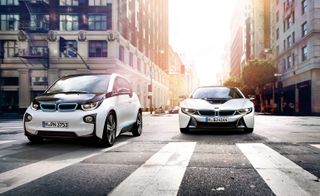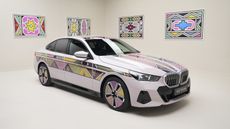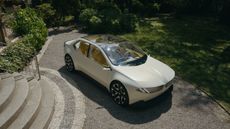BMW i: sustainable cities start to emerge

Creating a car company from scratch is not a simple undertaking. But that is effectively what BMW did when they launched the BMW i sub-brand back in 2011. Long before the i3 was simultaneously revealed around the world on 29 July 2013, the company had spent two intensive years of marketing, with many more years of before that trialling the technologies and exploring the materials that went into shaping the i3 and i8 you see on the roads today.
This commitment of time and energy has helped steer BMW i towards great acclaim; together, the i3 and i8 have won a startling number of awards (the latest being World Green Car Award and a nomination for the Design Museum’s Designs of the Year for the i8.) But it also laid the fundamental values for BMW i, values that will only become more and more important as the market for hybrid and electric cars grow. For BMW i is a truly sustainable car brand, successfully closing the complex loop of manufacturing, materials production, electricity usage and recycling.
While we’ve enjoyed getting behind the wheel of the BMW i cars, there’s clearly a lot going on behind the scenes. The sustainable loop begins at the various factories and facilities that create the cars. A fair chunk of both ‘i' cars start their lives at a new facility in Moses Lake, Washington, USA, where BMW has invested considerably in creating the world’s most advanced carbon fibre factories. Moses Lake produces the bundles, or rovings, of raw carbon fibre, an energy-intensive process which is entirely off-set by the plant’s 100% commitment to hydro-electric power, making the CF production carbon neutral. The rovings are woven into carbon laminates at BMW’s Plant Wackersdorf before being transferred to its Leipzig factory, home of the i3 and i8, where they’re pressed with resin to form the structure and panels of the cars. The Leipzig factory was designed by Zaha Hadid Architects and originally opened in 2005. A futuristic, innovative structure, the plant was the first step in the infrastructure that shaped BMW i.
The alchemical transformation of raw material into finished car is only the start of the story. The i3 and i8 make extensive use of recycled and renewable raw materials as well as cutting edge new composites, and the company’s €400m investment in the Leipzig factory has created a low-energy, partly naturally lit workspace where the process of car making has been refined to take advantage of the modular style construction used in the i3 and i8. If you’re lucky enough to get the cars on the road then other degrees of the virtuous circle start to fall into place.
From the outset, BMW i has exploited technology to make the driving experience more seamless, dovetailing personal mobility with the ebb and flow of public and private transport systems. The i3 was always aimed at the city dweller, and drivers have access to BMW ConnectedDrive, a suite of services that pairs a smartphone with satnav and sensors, bringing together details of your journey, range, charge stations and the parking situation in your destination. This makes for a far more efficient relationship between driver and car, helping nibble away at wasted minutes spent searching for somewhere to park, for example.
It’s this holistic approach that marks out the BMW i experience. And at the end, their high proportion of recyclable materials will simply feed back into the production cycle. It’ll go further still as more and more charge stations come on line and initiatives like the DriveNow car-sharing service rolls out across more and more locations (it’s currently operating in London, Vienna, San Francisco and several major German cities).
Change takes time. Back at the start of the whole project ‘i', we worked with BMW i to explore a series of future visions, opening up new conversations about the role of transportation. But now the BMW i ecosystem is here, the world of personal mobility is clearly evolving in a new, more sustainable direction.

The i3 and i8 make extensive use of recycled and renewable raw materials as well as cutting edge new composites

Exploiting technology to its advantage, BMW i makes the driving experience more seamless
Wallpaper* Newsletter
Receive our daily digest of inspiration, escapism and design stories from around the world direct to your inbox
Jonathan Bell has written for Wallpaper* magazine since 1999, covering everything from architecture and transport design to books, tech and graphic design. He is now the magazine’s Transport and Technology Editor. Jonathan has written and edited 15 books, including Concept Car Design, 21st Century House, and The New Modern House. He is also the host of Wallpaper’s first podcast.
-
 Les Lalanne’s surreal world takes over Venice
Les Lalanne’s surreal world takes over Venice‘Planète Lalanne’, presented by Ben Brown Fine Arts, takes over Palazzo Rota Ivancich, with a cast of blue hippos, woolly sheep and giant grasshoppers
By Hannah Silver Published
-
 At home with Barnaba Fornasetti
At home with Barnaba FornasettiBarnaba Fornasetti invites us into Casa Fornasetti, a private residence and creative hub, as he carries on its founder’s perpetual exploration of creativity and design
By Maria Cristina Didero Published
-
 Niceworkshop explores the cycle of industrial materials at Milan Design Week
Niceworkshop explores the cycle of industrial materials at Milan Design WeekSeoul-based Niceworkshop caught the design world’s attention with its inaugural collection dedicated to the humble bolt. Now, with its first solo showing at Capsule Plaza, the studio aims to disrupt the life cycle of industrial materials with an exploration into aluminium formwork
By Laura May Todd Published
-
 BMW Vision Neue Klasse X reveals the shape of tomorrow’s electric SUV
BMW Vision Neue Klasse X reveals the shape of tomorrow’s electric SUVNew concept the BMW Vision Neue Klasse X previews the next-generation ‘X’ models
By Jonathan Bell Published
-
 BMW i5 Flow NOSTOKANA brings Esther Mahlangu’s art to life at Frieze LA
BMW i5 Flow NOSTOKANA brings Esther Mahlangu’s art to life at Frieze LABMW’s Art Car Project has rarely impacted on the company’s everyday business of building cars. With the BMW i5 Flow NOSTOKANA, could all that be about to change?
By Jonathan Bell Published
-
 Electric BMW CE 02 is an eParkourer for the urban jungle
Electric BMW CE 02 is an eParkourer for the urban jungleThe BMW CE 02 – BMW Motorrad’s second all-electric scooter –is aimed squarely at the urban rider, offering style and power in a bold new package
By George Chapman Published
-
 CES 2024 was a showcase for how to shoehorn AI into next-generation cars
CES 2024 was a showcase for how to shoehorn AI into next-generation carsCES 2024 in Las Vegas underlined that future mobility will be shaped by AI, like it or not, as intelligent assistants emerge to guide, plan and converse with their human cargo
By Jonathan Bell Published
-
 24 transportation design innovations for 2024
24 transportation design innovations for 2024From electric cars to new airports and sports boats, here’s a non-exhaustive list of 24 of the most interesting transportation design innovations to expect in the coming year
By Jonathan Bell Published
-
 80 years of BMW design in a monumental new book
80 years of BMW design in a monumental new book‘BMW: Behind the Scenes’ is billed as the ultimate book on the Bavarian carmaker’s aesthetic history
By Jonathan Bell Published
-
 Zoute Grand Prix is a car fest like no other at a pristine Belgian beachside town
Zoute Grand Prix is a car fest like no other at a pristine Belgian beachside townAmy Serafin takes to the well-heeled streets of Knokke-Heist to experience the Zoute Grand Prix, its annual cavalcade of classic car-related events, from a rally to an auction
By Amy Serafin Published
-
 BMW Vision Neue Klasse resets the company’s future electric strategy
BMW Vision Neue Klasse resets the company’s future electric strategyA minimal, pure design with reduced materials and components, the BMW Vision Neue Klasse updates the core visual elements of the brand
By Jonathan Bell Published